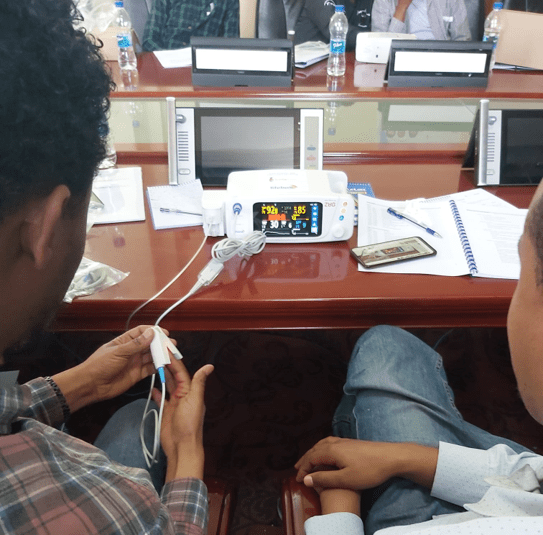
In anticipation of World Anesthesia Day, Smile Train, the world’s largest cleft organisation and Lifebox, a non-profit dedicated to safer surgery, have united to shine a light on and address a 30-year access gap that poses significant risks to individuals undergoing surgery in low-resource settings.
Capnography, a monitoring tool that gauges whether a patient is receiving sufficient air supply during anaesthesia, has been a fixture in operating rooms (ORs) in high-income nations for over three decades. Its introduction in the United States in 1991 resulted in a remarkable reduction in anesthesia-related complications and fatalities. Nonetheless, capnography remains largely unavailable in the majority of operating rooms in low-resource settings. Research has revealed that there is frequently a 100 per cent gap between the demand for capnography and its availability in low-income countries.
Capnography is the most effective tool for identifying a major cause of anaesthesia-related complications and deaths in low-resource settings: the misplacement of the breathing tube that delivers oxygen to the patient. Without a supply of oxygen, a patient may suffer catastrophic harm within minutes, including brain damage and death. Children are at a higher risk of having a misplaced breathing tube. Increasing the availability of capnography will significantly enhance anaesthesia safety for people, including children, undergoing surgery in low-resource settings.
“Administering anaesthesia without a capnograph is akin to flying blind – you lack the basic information required to keep them safe,” said Dr. Zipporah Gathuya, a pediatric anesthesiologist at the Nairobi Hospital in Kenya and a member of the Smile Train Global Medical Advisory Board. “As healthcare providers, we are concerned that our surgical patients are not monitored with this essential device, even though it’s standard practice in wealthy countries. Capnography shouldn’t be a privilege; it’s a demand for patient safety everywhere, and it’s needed now.”
Smile Train and Lifebox, in collaboration with industry partner Zug Medical Systems, are making the first high-quality, user-friendly and affordable capnograph available. The Smile Train-Lifebox Capnograph meets robust specifications for monitoring pediatric patients and for use in low-resource settings, having undergone rigorous laboratory and field testing.
What is now needed is a concerted effort by the World Health Organization to update global guidelines for safe anaesthesia to align with high-income practices. Changes to global guidelines and national practices would ultimately create market demand for more affordable and durable capnography suitable for use in resource-limited settings.
“Capnography has safeguarded surgical patients in the United States for over 30 years, yet, until now, this life-saving monitoring tool has unfortunately remained inaccessible for most operating rooms in Africa,” said anesthesiologist and director of programmes safety at Smile Train, Dr. Elizabeth Igaga. “The availability of the affordable Smile Train-Lifebox Capnograph is the first significant step to bridge this gap. We hope the WHO takes urgent steps to amend the guidelines for capnography use in safe anaesthesia, enabling its rapid adoption by low- and middle-income countries. Let’s close this gap and ensure that every surgical patient, regardless of their location, receives the care they deserve.”
This year, 350 low-resource operating rooms will be equipped with the new Smile Train-Lifebox Capnograph, along with training in its use for anaesthesia staff, in Benin, Ethiopia, the Philippines, and Uganda. This effort is part of the Smile Train-Lifebox Safe Surgery and Anesthesia Initiative, designed to enhance the safety of pediatric anaesthesia and surgical care in low- and middle-income countries.
“For over a decade, Smile Train has collaborated with Lifebox to supply hospitals worldwide with essential monitoring tools for children undergoing surgery,” said Smile Train president and CEO Susannah Schaefer. “The introduction of the Smile Train-Lifebox Capnograph will have a transformative impact on the safety of every child with a cleft undergoing surgery, strengthening surgical safety for all surgical patients as a result.”
In the same vein, the World Health Organisation-World Federation of Societies of Anesthesiologists (WHO-WFSA) was called upon to upgrade its capnography recommendations in the International Standards for a Safe Practice of Anesthesia from “recommended for patients undergoing general anaesthesia and deep sedation” to the highest category, “highly recommended”—the equivalent of a mandatory standard. Furthermore, the WHO’s Surgical Safety Checklist must include a capnograph, in addition to a pulse oximeter, as anaesthesia monitoring equipment is required for safe surgery.
The Smile Train-Lifebox Safe Surgery and Anesthesia Initiative is a multi-year strategic partnership elevating the quality and safety of cleft and pediatric surgery. Through innovations and training, the Initiative is strengthening surgical systems worldwide.


